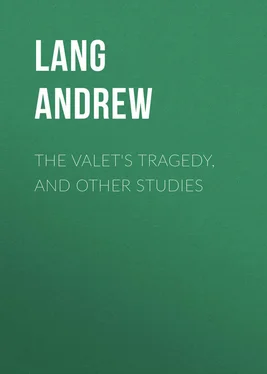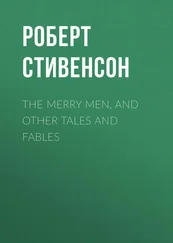Andrew Lang - The Valet's Tragedy, and Other Studies
Здесь есть возможность читать онлайн «Andrew Lang - The Valet's Tragedy, and Other Studies» — ознакомительный отрывок электронной книги совершенно бесплатно, а после прочтения отрывка купить полную версию. В некоторых случаях можно слушать аудио, скачать через торрент в формате fb2 и присутствует краткое содержание. Издательство: Иностранный паблик, Жанр: foreign_antique, foreign_prose, на английском языке. Описание произведения, (предисловие) а так же отзывы посетителей доступны на портале библиотеки ЛибКат.
- Название:The Valet's Tragedy, and Other Studies
- Автор:
- Издательство:Иностранный паблик
- Жанр:
- Год:неизвестен
- ISBN:нет данных
- Рейтинг книги:4 / 5. Голосов: 1
-
Избранное:Добавить в избранное
- Отзывы:
-
Ваша оценка:
- 80
- 1
- 2
- 3
- 4
- 5
The Valet's Tragedy, and Other Studies: краткое содержание, описание и аннотация
Предлагаем к чтению аннотацию, описание, краткое содержание или предисловие (зависит от того, что написал сам автор книги «The Valet's Tragedy, and Other Studies»). Если вы не нашли необходимую информацию о книге — напишите в комментариях, мы постараемся отыскать её.
The Valet's Tragedy, and Other Studies — читать онлайн ознакомительный отрывок
Ниже представлен текст книги, разбитый по страницам. Система сохранения места последней прочитанной страницы, позволяет с удобством читать онлайн бесплатно книгу «The Valet's Tragedy, and Other Studies», без необходимости каждый раз заново искать на чём Вы остановились. Поставьте закладку, и сможете в любой момент перейти на страницу, на которой закончили чтение.
Интервал:
Закладка:
Andrew Lang
The Valet's Tragedy, and Other Studies
PREFACE
These studies in secret history follow no chronological order. The affair of James de la Cloche only attracted the author’s attention after most of the volume was in print. But any reader curious in the veiled intrigues of the Restoration will probably find it convenient to peruse ‘The Mystery of James de la Cloche’ after the essay on ‘The Valet’s Master,’ as the puzzling adventures of de la Cloche occurred in the years (1668-1669), when the Valet was consigned to lifelong captivity, and the Master was broken on the wheel. What would have been done to ‘Giacopo Stuardo’ had he been a subject of Louis XIV., ‘’tis better only guessing.’ But his fate, whoever he may have been, lay in the hands of Lord Ailesbury’s ‘good King,’ Charles II., and so he had a good deliverance.
The author is well aware that whosoever discusses historical mysteries pleases the public best by being quite sure, and offering a definite and certain solution. Unluckily Science forbids, and conscience is on the same side. We verily do not know how the false Pucelle arrived at her success with the family of the true Maid; we do not know, or pretend to know, who killed Sir Edmund Berry Godfrey; or how Amy Robsart came by her death; or why the Valet was so important a prisoner. It is only possible to restate the cases, and remove, if we may, the errors and confusions which beset the problems. Such a tiny point as the year of Amy Robsart’s marriage is stated variously by our historians. To ascertain the truth gave the author half a day’s work, and, at last, he would have voted for the wrong year, had he not been aided by the superior acuteness of his friend, Mr. Hay Fleming. He feels morally certain that, in trying to set historians right about Amy Robsart, he must have committed some conspicuous blunders; these always attend such enterprises of rectification.
With regard to Sir Edmund Berry Godfrey, Mr. A. W. Crawley-Boevey points out to me that in an unpublished letter of Mr. Alexander Herbert Phaire in 1743-44 (Addit. MSS. British Museum 4291, fol. 150) Godfrey is spoken of in connection with his friend Valentine Greatrakes, the ‘miraculous Conformist,’ or ‘Irish Stroker,’ of the Restoration. ‘It is a pity,’ Mr. Phaire remarks, ‘that Sir Edmund’s letters, to the number of 104, are not in somebody’s hands that would oblige the world by publishing them. They contain many remarkable things, and the best and truest secret history in King Charles II.‘s reign.’ Where are these letters now? Mr. Phaire does not say to whom they were addressed, perhaps to Greatrakes, who named his second son after Sir Edmund, or to Colonel Phaire, the Regicide. This Mr. Phaire of 1744 was of Colonel Phaire’s family. It does not seem quite certain whether Le Fevre, or Lee Phaire, was the real name of the so-called Jesuit whom Bedloe accused of the murder of Sir Edmund.
Of the studies here presented, ‘The Valet’s Master,’ ‘The Mystery of Sir Edmund Berry Godfrey,’ ‘The False Jeanne d’Arc,’ ‘The Mystery of Amy Robsart,’ and ‘The Mystery of James de la Cloche,’ are now published for the first time. Part of ‘The Voices of Jeanne d’Arc,’ is from a paper by the author in ‘The Proceedings of the Society for Psychical Research.’ ‘The Valet’s Tragedy’ is mainly from an article in ‘The Monthly Review,’ revised, corrected, and augmented. ‘The Queen’s Marie’ is a recast of a paper in ‘Blackwood’s Magazine’; ‘The Truth about “Fisher’s Ghost,”’ and ‘Junius and Lord Lyttelton’s Ghost’ are reprinted, with little change, from the same periodical. ‘The Mystery of Lord Bateman’ is a recast of an article in ‘The Cornhill Magazine.’ The earlier part of the essay on Shakespeare and Bacon appeared in ‘The Quarterly Review.’ The author is obliged to the courtesy of the proprietors and editors of these serials for permission to use his essays again, with revision and additions.*
*Essays by the author on ‘The False Pucelle’ and on ‘Sir Edmund Berry Godfrey’ have appeared in The Nineteenth Century (1895) and in The Cornhill Magazine, but these are not the papers here presented.
The author is deeply indebted to the generous assistance of Father Gerard and Father Pollen, S.J.; and, for making transcripts of unpublished documents, to Miss E. M. Thompson and Miss Violet Simpson.
Since passing the volume for the press the author has received from Mr. Austin West, at Rome, a summary of Armanni’s letter about Giacopo Stuardo. He is led thereby to the conclusion that Giacopo was identical with the eldest son of Charles II. – James de la Cloche – but conceives that, at the end of his life, James was insane, or at least was a ‘megalomaniac,’ or was not author of his own Will.
I. THE VALET’S TRAGEDY
The Mystery of the Man in the Iron Mask is, despite a pleasant saying of Lord Beaconsfield’s, one of the most fascinating in history. By a curious coincidence the wildest legend on the subject, and the correct explanation of the problem, were offered to the world in the same year, 1801. According to this form of the legend, the Man in the Iron Mask was the genuine Louis XIV., deprived of his rights in favour of a child of Anne of Austria and of Mazarin. Immured in the Isles Sainte-Marguerite, in the bay of Cannes (where you are shown his cell, looking north to the sunny town), he married, and begot a son. That son was carried to Corsica, was named de Buona Parte, and was the ancestor of Napoleon. The Emperor was thus the legitimate representative of the House of Bourbon.
This legend was circulated in 1801, and is referred to in a proclamation of the Royalists of La Vendee. In the same year, 1801, Roux Fazaillac, a Citoyen and a revolutionary legislator, published a work in which he asserted that the Man in the Iron Mask (as known in rumour) was not one man, but a myth, in which the actual facts concerning at least two men were blended. It is certain that Roux Fazaillac was right; or that, if he was wrong, the Man in the Iron Mask was an obscure valet, of French birth, residing in England, whose real name was Martin.
Before we enter on the topic of this poor menial’s tragic history, it may be as well to trace the progress of the romantic legend, as it blossomed after the death of the Man, whose Mask was not of iron, but of black velvet. Later we shall show how the legend struck root and flowered, from the moment when the poor valet, Martin (by his prison pseudonym ‘Eustache Dauger’), was immured in the French fortress of Pignerol, in Piedmont (August 1669).
The Man, IN CONNECTION WITH THE MASK, is first known to us from a kind of notebook kept by du Junca, Lieutenant of the Bastille. On September 18, 1698, he records the arrival of the new Governor of the Bastille, M. de Saint-Mars, bringing with him, from his last place, the Isles Sainte-Marguerite, in the bay of Cannes, ‘an old prisoner whom he had at Pignerol. He keeps the prisoner always masked, his name is not spoken… and I have put him, alone, in the third chamber of the Bertaudiere tower, having furnished it some days before with everything, by order of M. de Saint-Mars. The prisoner is to be served and cared for by M. de Rosarges,’ the officer next in command under Saint-Mars.*
*Funck-Brentano. Legendes et Archives de la Bastille, pp. 86, 87,
Paris, 1898, p. 277, a facsimile of this entry.
The prisoner’s death is entered by du Junca on November 19, 1703. To that entry we return later.
The existence of this prisoner was known and excited curiosity. On October 15, 1711, the Princess Palatine wrote about the case to the Electress Sophia of Hanover, ‘A man lived for long years in the Bastille, masked, and masked he died there. Two musketeers were by his side to shoot him if ever he unmasked. He ate and slept in his mask. There must, doubtless, have been some good reason for this, as otherwise he was very well treated, well lodged, and had everything given to him that he wanted. He took the Communion masked; was very devout, and read perpetually.’
Читать дальшеИнтервал:
Закладка:
Похожие книги на «The Valet's Tragedy, and Other Studies»
Представляем Вашему вниманию похожие книги на «The Valet's Tragedy, and Other Studies» списком для выбора. Мы отобрали схожую по названию и смыслу литературу в надежде предоставить читателям больше вариантов отыскать новые, интересные, ещё непрочитанные произведения.
Обсуждение, отзывы о книге «The Valet's Tragedy, and Other Studies» и просто собственные мнения читателей. Оставьте ваши комментарии, напишите, что Вы думаете о произведении, его смысле или главных героях. Укажите что конкретно понравилось, а что нет, и почему Вы так считаете.











